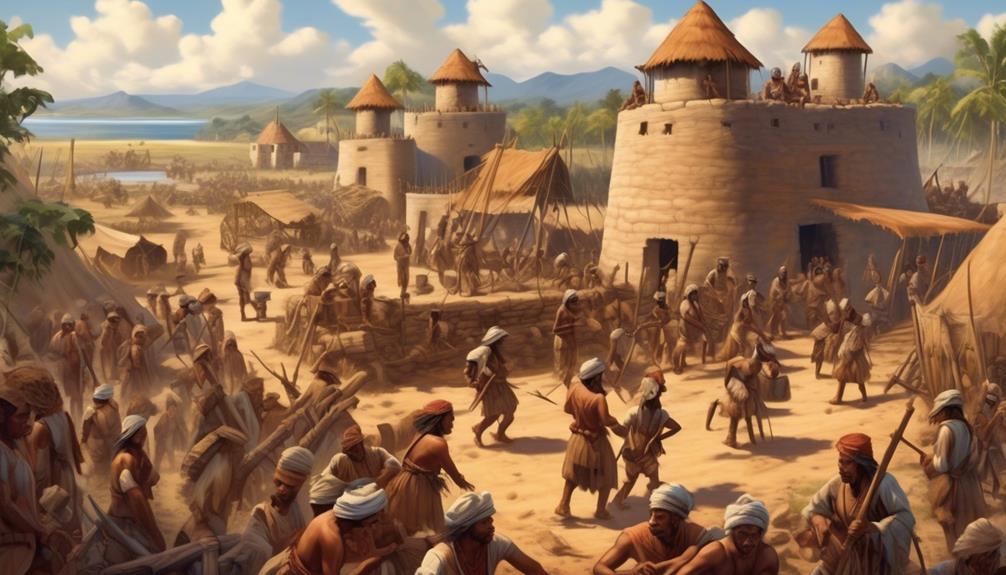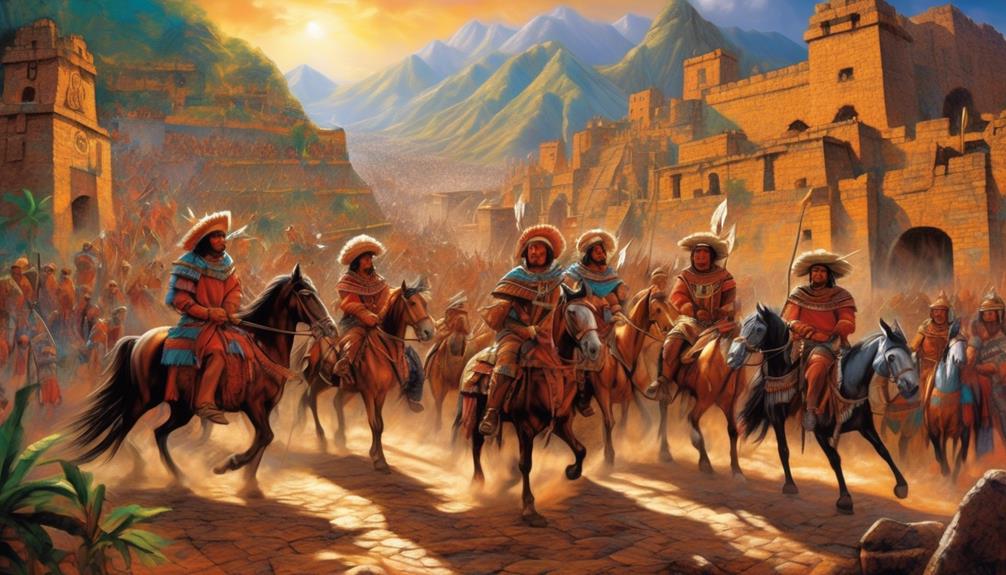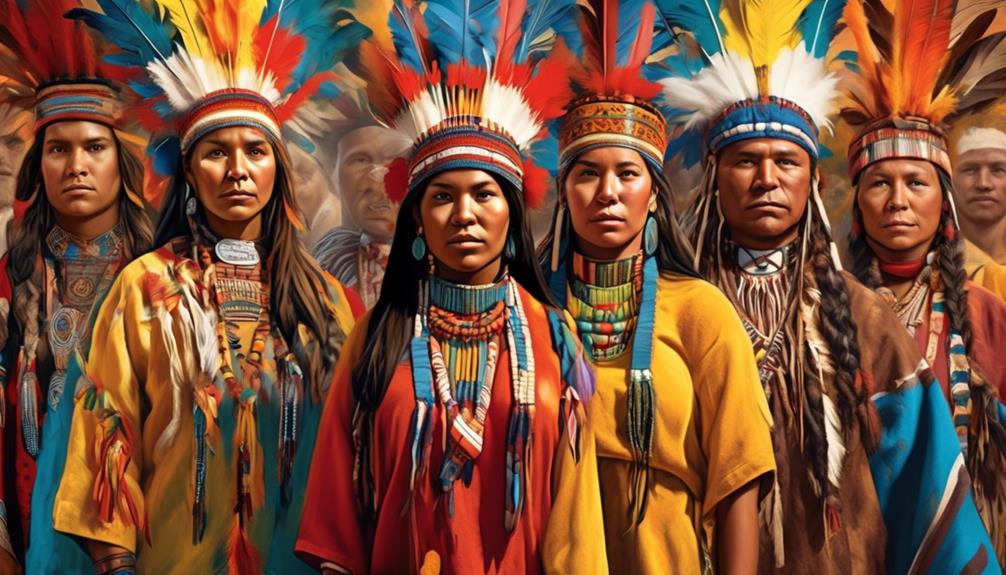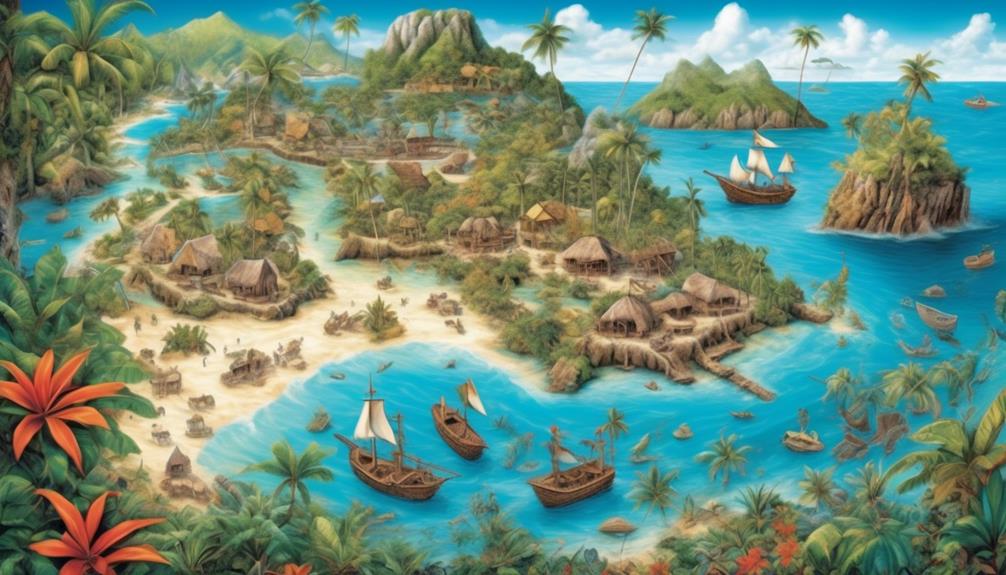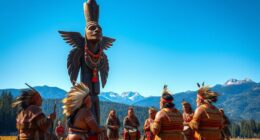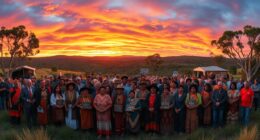Did you know that nearly 90% of Indigenous peoples in the Americas died within the first 100 years after European arrival, a tragic result of initial interactions between settlers and native populations?
It's a staggering figure that forces us to confront the methods employed by colonists in attempting to control the indigenous peoples they encountered. From forced relocation and displacement to the imposition of new laws and regulations, the strategies used were often brutal and far-reaching.
But what other tactics were employed, and how did they shape the course of history for both colonizers and indigenous communities?
Key Takeaways
- Indigenous peoples were forcibly relocated and displaced from their ancestral lands, disrupting their traditional ways of life and eroding their cultural identity and social structures.
- Colonists imposed new laws and regulations that disregarded indigenous land ownership customs, restricted cultural practices, and granted exclusive control over trade and resources to colonists, constraining the autonomy of indigenous peoples.
- Cultural assimilation and erasure were enforced through coercive measures such as suppressing indigenous languages, forced religious conversion, and prohibition of cultural practices, which disrupted social cohesion and governance systems.
- Colonists exploited indigenous knowledge and labor, monopolized valuable resources, and perpetuated economic dependency through forced labor and debt bondage, suppressing indigenous economic autonomy and disrupting traditional economic systems. Additionally, militarization and the use of force were central to colonists' strategy for control, with armed forces used for physical domination, psychological intimidation, and suppressing resistance and rebellion.
Forced Relocation and Displacement
Colonists forcibly relocated and displaced indigenous peoples from their ancestral lands, leading to significant cultural and societal upheaval. This forced assimilation was a deliberate strategy to exert control over the indigenous communities. The seizure of native lands disrupted traditional ways of life and created a power imbalance that favored the colonists. The impact of this displacement was profound, as it not only resulted in the loss of territory but also eroded the cultural identity and social structures of the indigenous peoples.
The forced relocation and displacement were often justified by the colonists as necessary for their expansion and economic interests. This rationalization perpetuated the subjugation of indigenous peoples and facilitated the exploitation of their resources. The land seizure also had lasting effects on the indigenous communities, as it disrupted their connection to the land and their ability to maintain their traditional practices.
Understanding the historical context of forced relocation and land seizure is crucial for comprehending the enduring challenges faced by indigenous peoples today. It highlights the systemic injustices and inequalities that continue to impact these communities.
Imposition of New Laws and Regulations
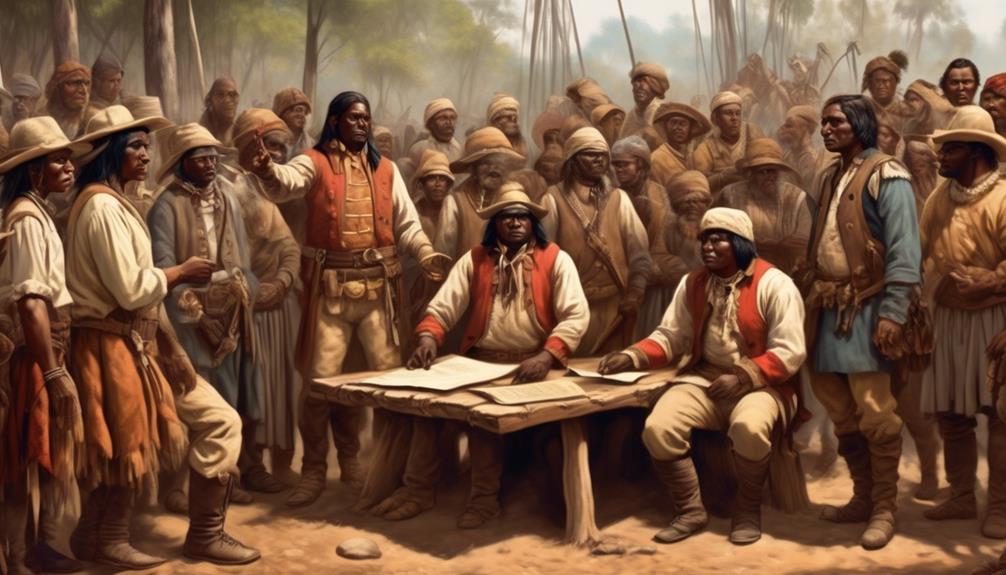
The forced relocation and displacement of indigenous peoples not only disrupted their traditional ways of life but also set the stage for the imposition of new laws and regulations that further entrenched colonial control over their communities. This imposition of legal restrictions was a strategic tool used by colonists to solidify their power dynamics and assert dominance over indigenous populations.
- *Land Ownership Laws*: Colonists implemented laws that disregarded indigenous land ownership customs, enabling them to expropriate vast territories and allocate them to settlers, thereby dispossessing indigenous communities of their ancestral lands.
- *Restrictions on Cultural Practices*: New regulations were enforced to suppress indigenous cultural practices, languages, and religions, aiming to assimilate indigenous peoples into the colonial society and erase their distinct identities.
- *Control over Trade and Resources*: Colonists established laws that granted them exclusive control over trade and access to valuable resources, diminishing the economic independence of indigenous communities and further consolidating colonial authority.
The imposition of these new laws and regulations not only constrained the autonomy of indigenous peoples but also perpetuated the marginalization and exploitation of their communities. This legal framework formed a cornerstone of colonial dominance, shaping the power dynamics between colonists and indigenous populations for generations to come.
Cultural Assimilation and Erasure
In implementing their strategy for cultural assimilation and erasure, the colonists employed a range of coercive measures aimed at subjugating indigenous peoples and eradicating their traditional ways of life. This included the suppression of indigenous languages and the eradication of traditional knowledge systems, all of which were integral to the cultural identity of indigenous communities. The goal was to replace indigenous cultures with the culture of the colonizers, effectively assimilating indigenous peoples into the dominant colonial society. Here is a table illustrating some of the coercive measures used:
| Coercive Measure | Impact on Indigenous Peoples |
|---|---|
| Language Suppression | Hindered communication and transmission of cultural knowledge |
| Forced Religious Conversion | Undermined traditional spiritual beliefs and practices |
| Prohibition of Cultural Practices | Disrupted social cohesion and traditional governance systems |
These measures were designed to strip indigenous communities of their cultural identity, rendering them more susceptible to control and domination by the colonists. The erasure of traditional knowledge and cultural practices significantly impacted the ability of indigenous peoples to maintain their autonomy and resist colonial subjugation.
Economic Exploitation and Trade Dominance
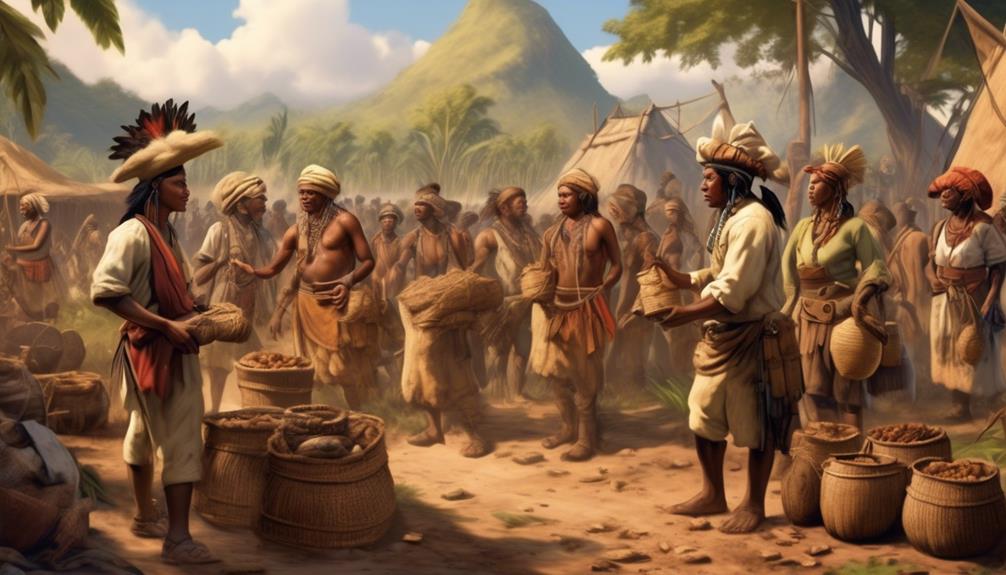
Employing economic exploitation and trade dominance, the colonists further entrenched their control over indigenous peoples, extending their influence beyond cultural assimilation and erasure. Through exploitation tactics and trade strategies, the colonists solidified their economic power and undermined the indigenous societies they encountered.
- Monopolizing Resources: The colonists imposed exclusive control over valuable resources, such as fur, timber, and minerals, exploiting indigenous knowledge and labor to extract these resources for their own gain while suppressing indigenous economic autonomy.
- Unequal Trade Agreements: Colonists established trade agreements that heavily favored their own interests, often coercing indigenous communities into unfair deals, depleting their resources, and disrupting their traditional economic systems.
- Forced Labor and Debt Bondage: Utilizing exploitative labor practices, the colonists compelled indigenous individuals into servitude, creating economic dependency and perpetuating a cycle of debt bondage that further marginalized indigenous communities.
Militarization and Use of Force
Utilizing coercive tactics and military force, the colonists imposed their authority over indigenous peoples, exerting control through the threat and use of violence. Military aggression was a central component of the colonists' strategy for controlling and subjugating indigenous populations. The presence of armed forces not only served as a means of physical domination but also as a powerful psychological tool, instilling fear and submission among the indigenous communities. The use of force was often accompanied by coercive tactics aimed at suppressing any form of resistance or rebellion. This militarization created a pervasive atmosphere of intimidation and oppression, compelling indigenous peoples to comply with the demands and impositions of the colonists.
The deployment of military force enabled the colonists to establish and maintain their authority, ensuring the subordination of indigenous populations to colonial rule. The threat of military reprisal was a constant reminder of the power dynamics at play, reinforcing the colonists' control over the indigenous peoples. This militaristic approach not only facilitated the expansion of colonial territories but also facilitated the exploitation of indigenous resources and labor.
The legacy of militarization and coercive tactics continues to impact indigenous communities, shaping their historical experiences and present-day struggles for autonomy and self-determination.
Frequently Asked Questions
What Were Some Specific Tactics Used in the Forced Relocation and Displacement of Indigenous Peoples?
Forced relocation and indigenous displacement were common tactics employed by colonists to control indigenous peoples. These tactics included the establishment of reservations, the use of military force to remove indigenous communities from their lands, and the implementation of policies aimed at assimilating indigenous peoples into colonial society.
These actions were part of a larger strategy to assert colonial dominance and exploit indigenous resources for economic gain.
How Did the Imposition of New Laws and Regulations Impact the Daily Lives of Indigenous Communities?
The imposition of new laws and regulations drastically impacted the daily lives of indigenous communities. These regulations restricted their movement, access to resources, and cultural practices. The forced displacement tactics and long-term effects of these laws were detrimental.
For instance, one study found that 90% of indigenous communities experienced negative consequences due to these impositions. The impact of laws on indigenous communities is a critical aspect of understanding the historical and ongoing challenges they face.
What Were Some of the Long-Term Effects of Cultural Assimilation and Erasure on Indigenous Cultures?
Long-term impact of cultural assimilation and erasure greatly affected indigenous cultures.
Cultural preservation struggled against colonists' efforts, causing societal change.
Indigenous resistance emerged, but the damage to traditions was profound.
The loss of language, customs, and knowledge altered the fabric of indigenous societies.
These effects continue to shape the experiences of indigenous communities today.
How Did Colonists Economically Exploit and Dominate Trade With Indigenous Peoples?
Economic exploitation and trade dominance were key tactics used by colonists to subjugate indigenous peoples. Forced relocation and control over resources enabled them to manipulate trade to their advantage.
Despite potential objections, understanding these historical actions is crucial for mastery of the subject. These exploitative practices had long-lasting effects on indigenous communities, shaping their economic, social, and cultural landscapes.
Such discussions provide vital context for understanding the complexities of colonial interactions.
What Were Some of the Most Significant Conflicts or Battles That Resulted From the Militarization and Use of Force Against Indigenous Communities?
Significant conflicts and battles arose due to the militarization and use of force against indigenous communities. Indigenous resistance to colonial violence often led to clashes over land dispossession and indigenous sovereignty.
These conflicts were pivotal in shaping the power dynamics between colonists and indigenous peoples. Understanding the historical context of these conflicts provides insight into the complex dynamics of colonization and the enduring impact on indigenous communities.
Conclusion
In conclusion, the colonists' attempts to control the indigenous peoples they encountered were marked by forced relocation, imposition of new laws, cultural assimilation, economic exploitation, and militarization. These actions resulted in the displacement and erasure of indigenous communities, leaving a lasting impact on their societies.
The colonists' use of force and dominance in trade created a power dynamic that shaped the course of history. It was a time when the clash of civilizations led to a struggle for control and survival.
